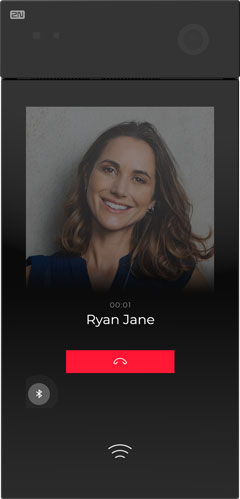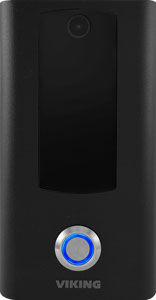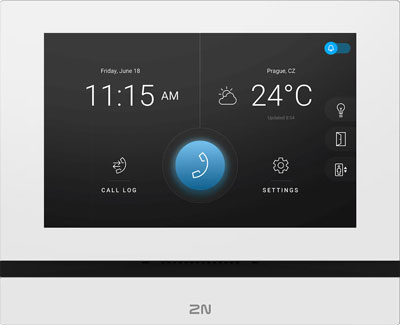Here’s an apparently simple question: what is a video intercom?
Well, it’s an intercom that supports video, right? Seems simple enough. Except.
Does that mean it just has a video camera? What kind of video camera? Does it have a display that shows video? Is that video one-way or two-way?
You can see how a simple question becomes complex. When shopping for a video intercom, the term “video” can mean a lot of things.
In this blog, we introduce the various meanings of video intercom using examples from 2N and Viking, two of the most prominent intercom manufacturers. Based on these examples, you’ll know what features to look for when buying a video intercom.
Let’s get into it!

What Does Video Intercom Mean?
When shopping for a video intercom, there are a few features you need to examine to know what “video” really means:
- Does it have a camera? Some video intercoms have a display and only support video input, which lets you, for example, monitor a doorway but not hold a video conversation. If you want a video intercom with a camera, make sure it has one.
- What kind of camera does it have? There are video intercoms with IP cameras and video intercoms with CCTV cameras. Make sure you’re getting the type of camera that works with your intercom infrastructure and platform.
- What are the specs on the camera? Like any other camera, video intercom cameras vary widely in terms of the video resolution, field of view, and more.
- Does it have a display? Many video intercoms only have a camera; you can’t watch video on them. If you want to see video on the intercom unit, make sure it has a display that supports that feature.
- Is the video support one-way or two-way? If you want to be able to hold video conversation on the intercom, make sure it supports two-way video calls.
Let’s give some examples.

Viking Electronics makes a variety of video intercoms and video entry phones. When Viking uses the term “video,” they mean that the intercom has a camera in it. As of the publishing of this blog (July 2025), they don’t make a video intercom with a display.
Viking produces video intercoms with one of two types of cameras: CCTV or IP.
CCTV cameras are analog security cameras that use dedicated wiring for connectivity. IP cameras are network-connected cameras that use internet technologies like Ethernet cables for connectivity.
The important thing to know with Viking video intercoms is that they offer IP video intercoms with CCTV cameras like the K-1705-IP Series. The intercom is network-connected, but the camera requires the dedicated analog wiring, analog recorders, and so on of a traditional CCTV system.
You can, however, use a video encoder like Axis M7116 to convert a CCTV signal into an IP signal, which lets you integrate an analog video intercom into an IP system.
Viking video intercoms like those in the X-Series have IP cameras, which means you can integrate your IP video intercom with your other IP systems, use Ethernet cabling, and so on — a unified system. IP cameras also often have much better resolution than CCTV cameras, which is very important.
Some IP video intercoms even support advanced features, like 2N IP Style, which has Adaptive Face Zooming. Sounds cool! It means that camera automatically detects faces and zooms in on them. It’s the equivalent of automatic speaker tracking used by video conferencing systems — a very desired feature in that arena.
With IP cameras, you should look to see if it lists ONVIF support. ONVIF is a set of open interoperability standards, which let you use a device from one manufacturer with devices or systems with other manufacturers.
For IP video intercom cameras, the important one to know is ONVIF Profile S, which ensures basic video streaming across platforms. ONVIF Profile T ensures advanced video streaming. Unless you’re 100% sure you’ll be using a one-manufacturer solution for the duration of your IP intercom system, ONVIF support is important. Thankfully, most manufacturers support ONVIF now. Still, check before purchase!
Enough about the camera. Let’s get into the display.

An intercom’s display can be used for many things. It can be a keypad, a directory, a map, and much more. It can be a touch display or not.
It can also support video, which means it can also be, basically, a TV.
Video intercoms either support one-way or two-way (bi-directional) video. Some support both. Make sure to check before purchase!
One-way video intercoms support video input to the answering end of the call. Someone presses the button on the intercom, and the answering end can see them.
Why would you want a video intercom with only video input? This type of intercom lets you see who’s at the door. For example, you might want to see that a visitor is who they say they are or monitor a delivery person who’s dropping off a package.
Think of it like the video doorbell you might have installed to make sure your packages don’t get stolen. You don’t want to show your face to the delivery person, but you do want to see them.
It’s the same idea with one-way video intercoms.
2N Indoor View is an indoor station with a 7-inch touchscreen display. It’s also a video intercom. In this case, “video” means that Indoor View can receive video. It doesn’t have a camera, so it can’t send video.
But there are two-way video intercoms.
We mentioned 2N IP Style above for its Adaptive Face Zooming. IP Style is a video intercom that combines everything: it has a camera and supports two-way video.
Two-way video intercoms are used to hold video calls with visitors. Rather than just seeing them, you can fully interact with them. It’s a level of interaction that many of us appreciate and even expect nowadays. Because of this, it future-proofs your video intercom investment. It can even improve accessibility, letting hearing-challenged visitors use sign language.
Typically, you’ll be able to configure the intercom in one-way or two-way mode, so if you find that you no longer want to use it in two-way mode or if the intercom’s other features are desirable but you don’t want two-way video, you don’t need to.
Bi-directional video intercoms are still comparatively rare, but more and more are showing up nowadays.
So, as you can see, “video intercom” can mean a whole lot of things.
If you still have questions, get in touch. Our friendly experts are here to help!

